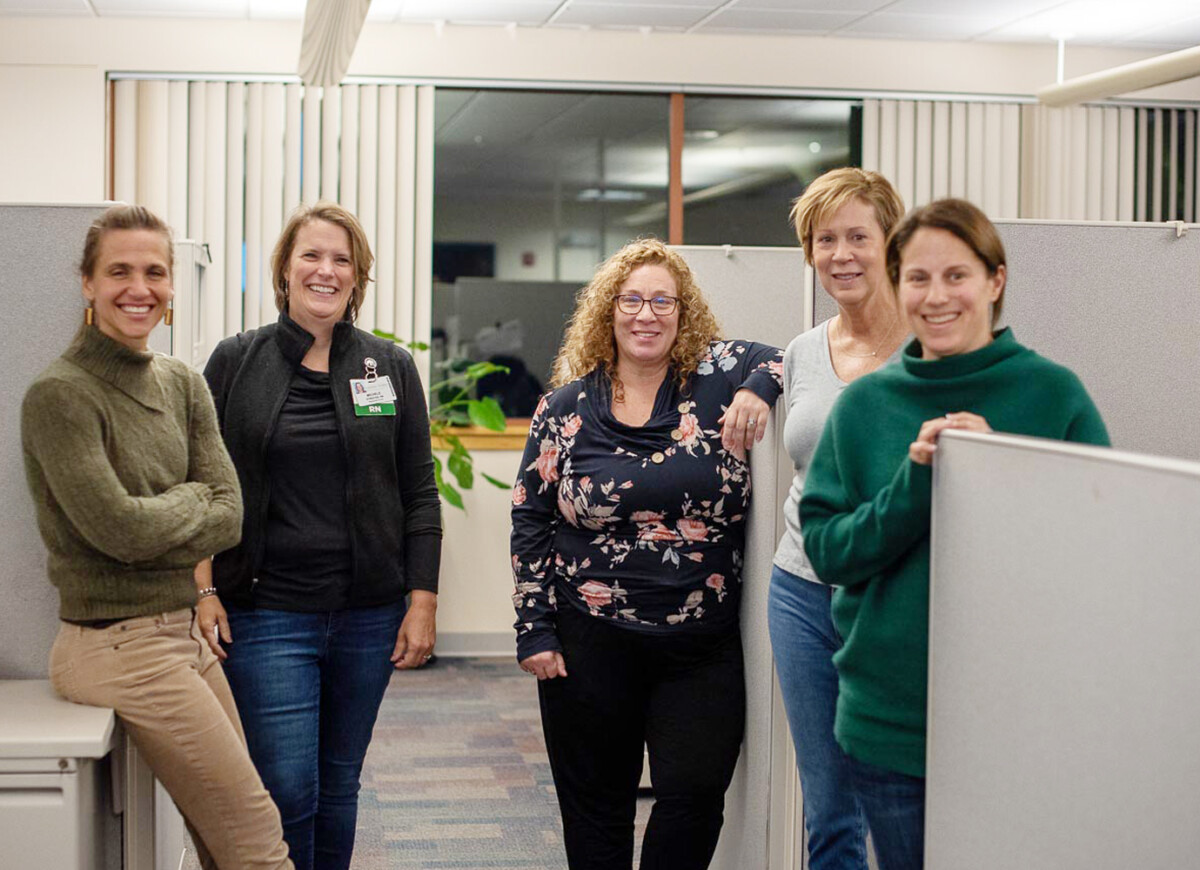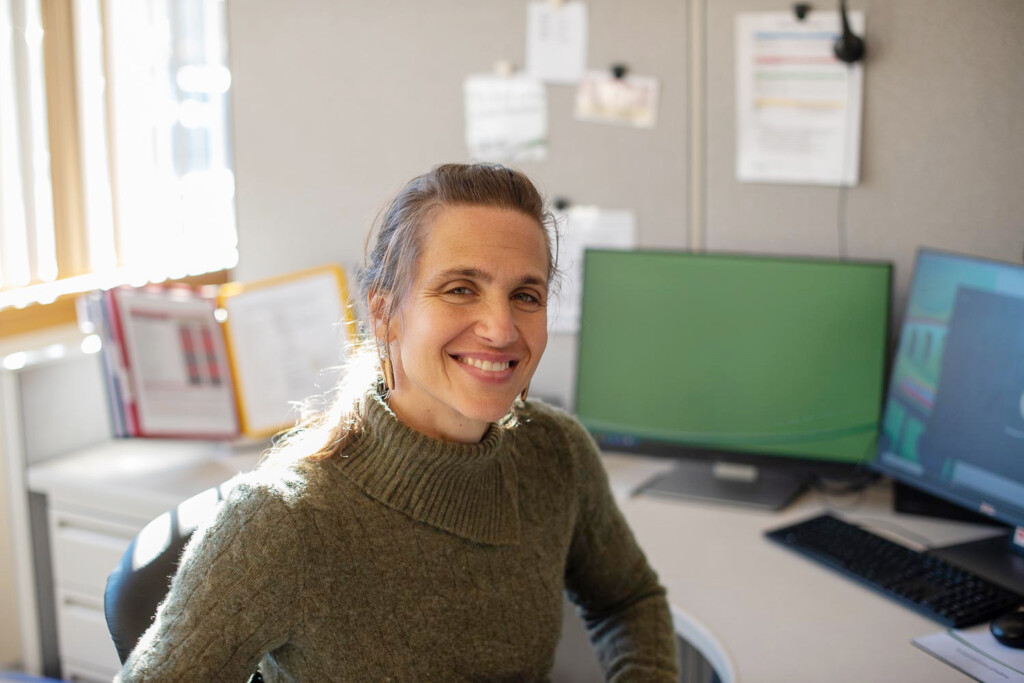‘Welcome to Air Traffic Control’

It’s still dark as Karen Harris crosses the parking lot to her office building, which is already humming with activity. A dozen nurses are at work, fielding the first of hundreds of calls they’ll receive that day from doctors, nurses and health care staff across the region. There are no patient beds nearby, but through their headsets and computer monitors, these nurses are a crucial part of the health care system serving the people of Vermont and northern New York.
“Welcome to ‘air traffic control’,” Harris says with a smile. “The UVM Health Network transfer center.”
The Best Quality Care, Close to Home
Like many of her colleagues, Harris has been a registered nurse for more than 20 years. Together, they bring decades of experience working across different parts of the health care system, from emergency departments and intensive care units to skilled-nursing facilities, specialist practices and primary care. Now these nurses work largely behind the scenes, utilizing their expertise to provide the services and infrastructure that connect hospitals into a cohesive health system that is stronger than its parts.
“Our goal is to help every patient get the best quality care as close to home as humanly possible,” says Daljit Kaur, RN, a nurse with the transfer center.
To do that, transfer center nurses like Kaur and Harris spend each day working with health care providers and nurses from hospitals around the region – including many community hospitals and care facilities outside of the UVM Health Network – to coordinate a patient’s care journey. As the center’s name suggests, this often involves helping a patient to transfer from one medical facility to another to receive the care they need.
For some, this could mean a quick overnight move from their community hospital to a larger hospital for a routine procedure from a specialist. For others – particularly people experiencing a medical emergency such as a stroke or serious injury – a timely transfer to a higher level of care can mean the difference between life and death.
Although we’re not physically with our patients, we’re their advocates as they move through our health system, helping them to get the right care at the right time.
Daljit Kaur, RN
This commitment runs deep. On a recent case, Kaur helped a patient return home after landing in the intensive care unit of a hospital in Southeast Asia. Diagnosed with a terminal illness, they were desperate to continue their care at home in Vermont. Kuar worked across time zones with the patient’s family, ICU staff, travel insurance companies, airlines and UVM Health Network physicians and specialists to chart a safe course home. Just 72 hours later, the patient arrived at the UVM Medical Center, where she was greeted by a team of health care providers with a plan in place for end-of-life care.
“This is an extreme example, but it shows the spirit of what we’re trying to do every day, for all of our patients” says Kuar. “The problem is, open beds are often hard to come by these days.”
‘A puzzle that fights back’
There are 1,500 patient beds in hospital care settings across the UVM Health Network, a figure which ebbs and flows with fluctuations in hospital staffing. “It’s our job to make the most of these resources,” says Matt Siket, MD, the head of the UVM Health Network care coordination system, a clinical team that includes the transfer center. “The problem is, open beds are often hard to come by these days – not just in our health system, but in health care facilities across the region.”
Due to the long lasting effects of the COVID-19 pandemic and some patients choosing to delay care at the time, the number of people today who require hospitalization continues to swell, with many requiring more care on average than several years ago. At the same time, a health care workforce shortage occurring across the nation is playing out locally in facilities in Vermont and northern New York. The end result is more patients than available beds, which means that some people remain in the hospital when they’d be better served in rehab or a skilled nursing facility; others have trouble getting back to a hospital close to home for recovery after a complex surgery at our academic medical center hospital; others receive mental health care in hospital settings because there are no beds at an inpatient psychiatric facility.
“It’s a massive puzzle, but a puzzle that constantly fights back,” says Jill O’Connell, RN, a transfer center nurse with more than 30 years of experience. “This makes it all the more important that hospitals in the region talk to one another to understand each other’s daily capacity to provide care and make the most efficient use of the beds we have available.”
If there is any silver lining to the pandemic at all, it’s that, COVID-19 helped speed along a more cooperative model among hospitals in our region. Transfer center leaders met daily with their counterparts at other hospitals to discuss capacity as they struggled to respond to the public health threat. Now that the urgency of COVID-19 has subsided, the daily touch-base remains: Every day, representatives from more than 20 hospitals in the region join a call to discuss bed availability and address bottlenecks across the region’s health system.
“It has done a tremendous amount to improve communication, collaboration and collegiality between the different hospitals in the region,” says Katelin Morrissette, MD, associate medical director of the care coordination system.
Harris agrees, and insists that this sort of cooperation is necessary to make lasting change as she examines yet another request for transfer.

This problem is bigger than our Network – this is a problem for our entire region. We’ve got to work together to get this right.
Karen Harris, RN
About the Care Coordination System
Every year, the transfer center handles more than 13,000 cases, and more than half of these involve a patient transfer. But in most cases, the transfer itself is just one of many ways in which the transfer center influences the care a person receives. Transfer center nurses also facilitate remote consultations between health care providers at different locations, bringing providers up to speed on the details of a case and helping them decide where a patient will received the best care.
The transfer center is one piece of the UVM Health Network care coordination system, a group of more than 130 health care providers, nurses, EMTs, paramedics, communications specialists and logistics experts that work together to coordinate safe, seamless care for patients. In addition to transfers and consultations, the care coordination system also coordinates ground and air ambulance transportation and communication, marshals medical resources to respond to emergencies, and manages bed planning and placement across the entire UVM Health Network.
